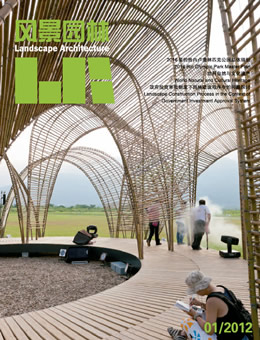撰文 (美) 乔 布莱恩 布雷
Text by Jon Bryan BURLEY (US)
翻译 邱慧
Translation by QIU Hui
校对 杨云峰
Proofreading by YANG Yun-feng
本文是《艺者匠心录》中的第4篇论文,陈述了研究城市和交通环境问题的自然科学方法。在美国,运输研究经费和调查活动为广泛的环境问题研究提供支持,而不仅仅局限于交通问题本身。交通研究有利于众多行业领域的发展以及新知识的更新。

该项研究的主要资金来源是多种交通运输形式的附加燃油税。税费支持基础设施建造和维护以及相关研究。风景园林设计师已成为这项活动的主要参与者。
在20世纪30年代,当时的公路研究委员会(Highway Research Board ,简称HRB,二战后发展成为交通运输研究委员会)在美国风景园林师协会(ASLA)的敦促下,在全国范围内对道路两侧发展的多方面状况进行调查。纳尔等人曾分析[1]:这项调查使得美国州属公路协会(American Association of State Highway Officials,简称AASHO)建议任命 一个由美国州属公路协会和公路研究委员会组成的联合委员会来共同管理道路两侧的发展。
委员会最早成立于1932年,康涅狄格州公路处卢瑟 M 肯思(Luther M.Keith)被任命为主席。第一届联合委员会由8名成员组成,其中4名委员来自公路研究局,另外4人是美国州属公路协会的工作人员,具体人员名单如下:
卢瑟 M 肯思(Luther M. Keith ),主席,康涅狄格州,路边发展委员会主任; 沃尔特 D 路德维希(Walter D. Ludwig),林务官,宾夕法尼亚州路政署; 哈罗德 J 尼尔(Harold J. Neale),风景园林工程师,弗吉尼亚州路政署; 弗兰兹 A 奥斯特(Franz A. Aust),风景园林副教授,美国威斯康星大学; 菲利普 H 艾尔伍德(Philip H. Elwood Jr.), 风景园林教授,美国爱荷华州立大学; 托马斯 H 考特(Thomas H. Cutler),AASHO总工程师,密苏里州高速公路委员会; 威尔伯 H 西蒙森(Wilbur H. Simonson),高级风景园林师,美国公共道路局; 佛兰西斯 W 索亚斯(Francis W. Sayers),路边改进工程师,密苏里州高速公路委员会。
该委员会设立了5个调查研究项目[1]:坡面侵蚀、教育与公共关系、分区、公路类型和道路地域、植物材料。
该委员会是交通运输研究委员会(The Transportation Research Board ,简称TRB)最早的外延机构。委员会经历了些许变化,如今名叫风景园林与环境设计委员会(Landscape and Environmental Design Committee),编号AFB40(前身A2A05),美国风景园林师协会会员、明尼苏达州运输部官员斯戈特 布拉德里(Scott Bradley)为委员会主席。委员会在华盛顿积极主办了交通运输研究委员会年度会议以及年中会议(图01)。
交通运输研究委员会是美国国家研究理事会的一部分。国家研究理事会服务于美国总统、美国国会以及许多联邦机构,是一个独立重要的科学和技术问题顾问。国家研究委员会由国家科学研究院,国家工程院和医学研究所共同管理。交通运输研究委员会涵盖面很广。年度会议在华盛顿特区举行,会议规模较大、内容综合且议题广泛。年中会议则相对更加有针对性。每年都有众多中国规划师、设计师、科学家和工程师参加交通运输研究委员会的年度会议并展示他们的论文和海报。中国跟美国一样,也是在运输问题研究上走在世界前列的国家。中国在交通网络发展上有很多宝贵经验值得世界其他国家借鉴。
在此框架下,李明翰博士是景观与环境设计委员会的活跃成员,非常受人尊重和钦佩。在德州农工大学工作期间,基于李明翰博士的研究兴趣,学校为其配备了德州运输研究所,该研究所是世界领先的交通运输问题研究机构之一。
通读全文者,均会对李博士的学术成就留下深刻印象,并坚信他的学术研究对于整个行业和环境发展的重要性。我希望你能够发现李博士的文章的趣味性,并从中受益。
注释:
图01为乔 布莱恩 布雷拍摄并授权使用。
参考文献:
[1] Harold J. Neale, Charles R. Anderson, Barbara M. Shaedler, and Nicholas R. Close. A Historical Review Of TRB Committee A2A05 Landscape And Environmental Design Committee[M]..TRB Committee A2A05 Landscape And Environmental Design Committee, Washington, DC. ,2002.
作者简介:
乔 布莱恩 布雷/博士/美国密歇根州立大学规划设计建设学院风景园林系教授/美国风景园林师协会资深会员
译者简介:
邱慧/1982年生/女/中南大学土木工程学院博士生/美国新墨西哥大学风景园林硕士/YouthLa志愿者翻译组组长(长沙 410083)
校对简介:
杨云峰/1981年生/男/博士/南京林业大学风景园林学院讲师/美国密歇根州立大学访问学者/本刊特约编辑/YouthLA核心编辑(南京 210037)
This is the fourth paper in the series and represents a physical science approach to urban and transportation environmental issues. In the United States of America, transportation research funds and investigational activities support a wide range of advancing environmental studies that are applicable to more than just transportation issues. Transportation research benefits many fields and professions in advancing new knowledge.
The primary source of funding for this research is the fuel tax imbedded in the many forms of transportation. The taxes support the construction and maintenance of infrastructure, plus research. Landscape architects have been a major player in this activity.
In the 1930s, the then Highway Research Board (HRB—leading to the Transportation Research Board after World War II) was urged by the American Society of Landscape Architects (ASLA) to make a nation wide survey of all aspects of roadside development. Neale et al. (2002) states:
This survey led to the American Association of State Highway Officials (AASHO) recommending the appointment of a joint Committee of AASHO and HRB on roadside development.
The original Committee was appointed in 1932 and Luther Keith of the Connecticut State Highway Department was named Chairman. The first Joint Committee was comprised of eight members, four from the Highway Research Board and four from the American Association of State Highway Officials. The Joint Roadside Development Committee of the Highway Research Board and the American Association of State Highway Officials 1932 were:
• Luther M. Keith, Chairman, Connecticut, Director of Roadside Development
• Walter D. Ludwig, Forester, Pennsylvania Department of Highways
• Harold J. Neale, Landscape Engineer, Virginia Department of Highways
• Franz A. Aust, Associate Professor of Landscape Design, University of Wisconsin
• Philip H. Elwood, Jr., Professor of Landscape Architecture, Iowa State College
• Thomas H. Cutler, AASHO Chief Engineer, Missouri State Highway Commission
• Wilbur H. Simonson, Senior Landscape Architect, U. S. Bureau of Public Roads and
• Francis W. Sayers, Engineer of Roadside Improvement, Missouri State Highway Commission.
This committee established five research investigations (Neale et al. 2002):
• slope erosion
• education and public relations
• zoning
• highway types and road areas and
• plant materials.
This committee is the oldest committee in the Transportation Research Board’s (TRB) extensive structure. The committee has gone through several changes and is currently known as the Landscape and Environmental Design Committee, AFB40 (formerly A2A05) with Scott Bradley, FASLA a landscape architect with the Minnesota Department of Transportation as the chair of the committee. The committee is very active hosting sessions at the Annual TRB meeting in Washington, DC, and also hosting a mid-year meeting (Fig.01).
TRB is part of the National Research Council in the United States of America. The National Research Council serves as an independent adviser to the President of the United States, the American Congress and the many federal agencies on scientific and technical questions of national importance. The National Research Council is jointly administered by the National Academy of Sciences, the National Academy of Engineering, and the Institute of Medicine. TRB is very interdisciplinary. The annual meeting in Washington, DC is huge, extensive and sprawling. The mid-year meetings are more intimate and focused. Numerous Chinese planners, designers, scientists, and engineers attend the TRB annual meeting presenting their papers and posters each year. China, like the United States is a leading nation in transportation research issues. Like the USA, the world has much to learn from the Chinese experiences in developing transportation networks.
Within this framework, Dr. Ming-Han Li is an active member of the Landscape and Environmental Design Committee and is highly respected and admired. Being at Texas A&M University facilitates Ming-Han’s interests through the Texas Transportation Institute, one of the world’s leading research organizations in transportation issues.
The reviewers of Dr. Li’s and co-authors’ manuscript were very impressed with his scholarship and believed that his ideas are important to the profession and environment. I hope that you will find this article interesting and illuminating.
Biography:
Dr. Jon Bryan BURLEY is a professor of Landscape Architecture at the School of Planning Design and Construction, College of Social Science and College of Agriculture and Natural Resources, Michigan State University. He is also a Fellow of American Society of Landscape Architects.
About the Translator:
QIU Hui , born in 1982, who received a MLA from the University of New Mexico in USA, is a PhD candidate of the School of Civil Engineering of Central South University in China. She is also in charge of the Volunteer Translators of YouthLa. (Changsha 410083)
About the Proofreader:
Dr.YANG Yun-feng, born in 1981, is a lecturer of the School of Landscape Architecture of Nanjing Forestry University and a visiting scholar of Michigan State University. He is a contributing editor for Landscape Architecture and a core editor of YouthLA. (Nanjing 210037)
 《风景园林》2012第1期导读
《风景园林》2012第1期导读
Leave a Reply